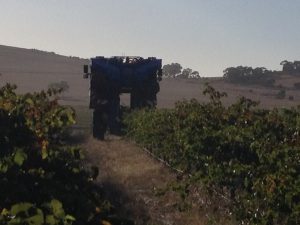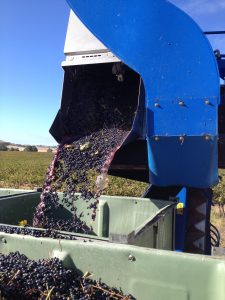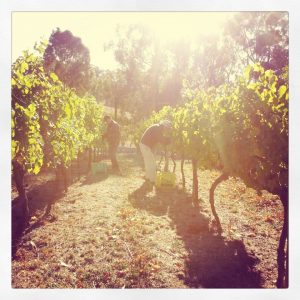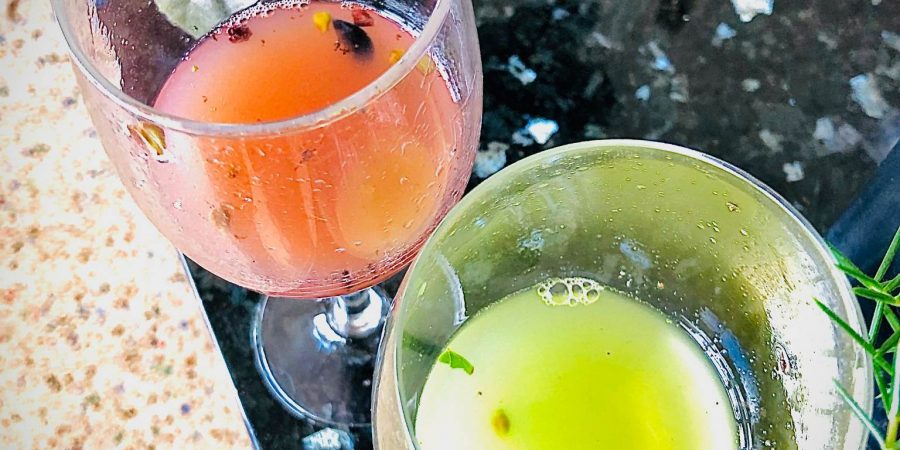I should really stop saying things out loud.
Last week I can be quoted as saying…
We’ve got some “showers” forecast for next week and fingers crossed they remain just that!
Well… those “showers” turned into “rain”. In fact, on Monday we had the highest amount of rainfall for the whole month at Mount Barker (13.4mm). And at Mount Lofty, they recorded the second highest for the month with 18.4mm..
And while that may not sound like much, it’s enough to cause headaches in the vineyard.
Not only does the extra rain increase the chance of botrytis and other fungal infection it’s delaying harvest even further. Grapes which were close to being ready have now taken up all that extra water and diluted out the sugars. So now we have to wait for those sugar levels to rise again before they’re ready to pick. At this rate, we won’t be picking some of our earliest varieties until next week. That means we’ll be picking Pinot for sparkling (usually the first to be picked) in April. And that’s practically unheard of and certainly a record for us!
It’s all good though. Rob and our trusted growers have it all in hand!
Here is a picture of the Sauvignon Blanc and Pinot juice from Kim Anderson’s vineyard earlier this week. Check out that colour!

As I said, Rob and Kim clearly have this all in hand.
Tune in next week, when no doubt, I’ll have further news on all the beautiful grapes we’ve picked.
Actually, should I have said that out loud??!
Until then, let’s recap on HOW the grapes get picked with this post from a few years back.
Take it away, circa-2018 Maree…
(have I really been doing this for 5 years??!)
Loving our blog? Sign up for weekly updates straight to your inbox…
[withwine type=’join-mailing-list’]
The romantics amongst us probably imagine that all grapes are lovingly picked by hand… gently placed into baskets and carried to the winery by dedicated but carefree workers basking in the glow of the late summer sun. No? Just me?
Well, traditionally grapes have always been picked by hand (I may have taken a little creative licence with the carefree basking). These days though, we also rely pretty heavily on machinery.
But it all depends a bit on the variety and style of wine.
Let’s take a closer look at each method and find out exactly what Rob does with his grapes…
Picking by hand
Hand-picking is obviously the gentlest way to handle grapes at harvest time. It allows the removal of whole bunches – leaving the berries attached to the stalks.
Mechanical harvesting
 Mechanical harvesters work by moving along the row and shaking the vines. This movement causes the berries to fall off their stalks.
Mechanical harvesters work by moving along the row and shaking the vines. This movement causes the berries to fall off their stalks.
There are several benefits to using machine over hand-picking. Firstly, and most obviously, it allows grapes to be picked at a fraction of the cost and time. This can be really important  when the grapes have reached their desired ripeness and need to be removed quickly. Secondly, these machines can pick through the night when temperatures are cooler. As we know, oxidation can occur at higher temperatures, so picking at night is often a better option if daytime temperatures are high. Ideally, grapes should be picked at an ambient temperature of between 8 and 16 degrees Celcius.
when the grapes have reached their desired ripeness and need to be removed quickly. Secondly, these machines can pick through the night when temperatures are cooler. As we know, oxidation can occur at higher temperatures, so picking at night is often a better option if daytime temperatures are high. Ideally, grapes should be picked at an ambient temperature of between 8 and 16 degrees Celcius.
So why pick by hand at all?
There are a few situations in which mechanical harvesters cannot be used…
Some vineyards are simply inaccessible to heavy equipment. Steep slopes can make mechanical harvesting impossible.
In other cases, the winemaking technique dictates the use of whole bunches. For example:
- in the production of premium sparkling wine where whole bunch pressing is used to extract the juice
- When red wines are made using carbonic maceration
- Where there is a need to select only certain bunches or parts of bunches due to the presence of disease.
Carbonic maceration is a winemaking technique in which whole grapes are fermented in a carbon dioxide rich environment prior to crushing. The result are wines that are fruity in aroma and flavours, sometimes with a distinct banana aroma. They lack tannins, and deep color. Carbonic Maceration is most commonly practiced in Beaujolais with the Gamay grape, which has thin skins and produces lots of fruity aromas and flavours.
Which method does Rob use?
 The Pinot Noir Rob uses for his Sparkling and Rose along with his Sauvignon Blanc are always hand-picked.
The Pinot Noir Rob uses for his Sparkling and Rose along with his Sauvignon Blanc are always hand-picked.
The main principle is to finish up with fine, delicate, low colour juice. The tannins also need to be low. Since colour, tannins and compounds leading to a bigger-bodied juice/wine are in the skins, it makes sense to keep berries/skins intact until the bunches get to the press. Machine harvesting always causes rupture of skins and release of juice, no matter how well it’s done.
For red wines and bigger-bodied whites such as Chardonnay, this extra extraction is not a problem, so all the varieties for dry red (Shiraz, Tempranillo and Pinot) are machine harvested. It’s also beneficial for Chardonnay to be machine picked as it helps to give more body, and the slight extra tannin is easily absorbed with the barrel ageing.
